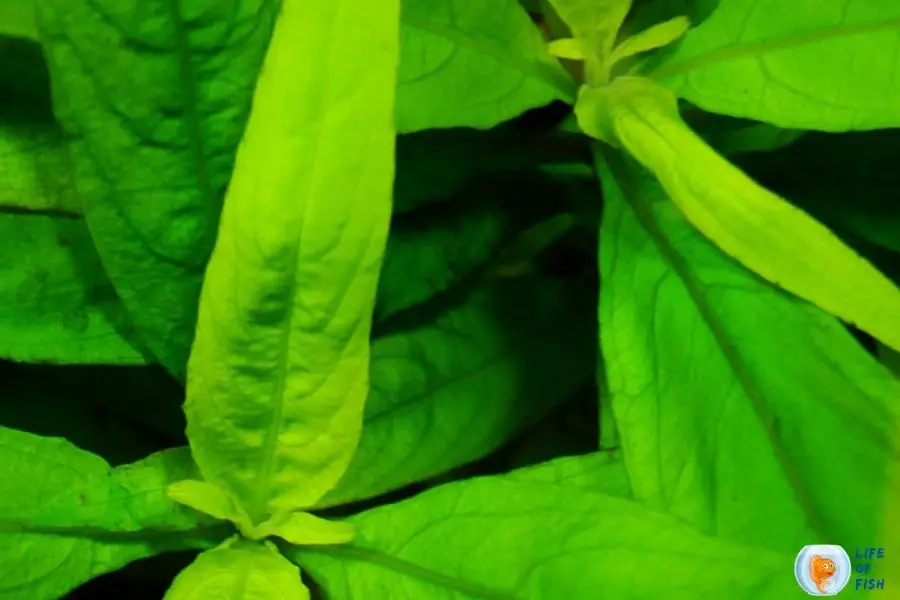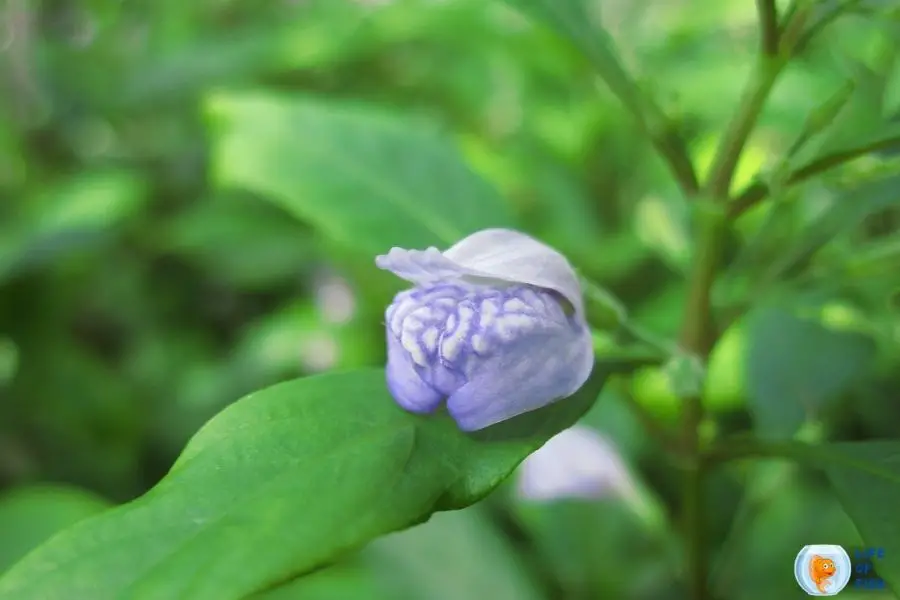The Hygrophila Corymbosa is a prevalent aquarium plant. It’s easy to see why this plant is colorful, hardy, and grows quickly!
They Care can be difficult for new aquarists; luckily, we’ve done all the research for you. Read on to find out how to care for your Hygrophila Corymbosa.

What is Hygrophila Corymbosa?
Jump To
- 1 What is Hygrophila Corymbosa?
- 2 How to identify?
- 3 Is Hygrophila Corymbosa easy to grow?
- 4 Distribution & natural habitat
- 5 One look care guide
- 6 Aquarium care requirements
- 7 How to keep Hygrophila Corymbosa alive
- 8 Hygrophila Corymbosa tankmates
- 9 Diseases and common problems, treatment
- 10 How to attach Hygrophila corymbosa
- 11 Why Hygrophila Corymbosa turning brown?
- 12 The benefits of Hygrophila Corymbosa in an aquarium
- 13 Final Thoughts
It is an aquatic plant native to Southeast Asian countries such as Malaysia, Thailand, Singapore, India, and Indonesia.
Hygrophila corymbosa is commonly known as starhorn, temple plant, and giant hygro and consists of several subspecies.
Stricta, Crispa, Gracilis, Fine Leaf, Willow Leaf, Glabra, Aroma, Strigosa, Compacta, Red, Angustifolia are some of the most well-known types.
The plant is a perennial plant with various color tones ranging from dark green to pink that may eventually develop into magenta.
The main reason for this color variation is the care level it receives from the owner. This plant produces purple flowers in optimum health conditions, but this is rare in aquariums.
Although it can live in tropical aquariums or some of its ecologically natural locations around the world, it cannot flourish as it does in the wild of Southeast Asia.
How to identify?
It is a stem plant with long, slim leaves and a creeping growth habit.
Hygrophila corymbosa can be identified by its narrow, lance-like leaves that look like arrows and the way they grow in whorls around their stem (also known as scorpioid cymes ).
The plant can grow as large as 24 inches. However, this depends on the subspecies. Some plants have a more compressed size and are suitable as foreground plants.
Therefore, you should be careful when choosing this plant; always ask which variety you are buying to ensure you get the right-sized plant.
Is Hygrophila Corymbosa easy to grow?
It is extremely easy to grow. It can grow in many types of water conditions and doesn’t need special care. However, if provided trace minerals, it will promote healthy growth.
As Hygrophila Corymbosa is native to South East Asia, the best temperature for this plant is 21 °C – 28 °C.
Distribution & natural habitat
These aquatic plants are distributed around South East Asia.
It is native to Southeast Asian countries like Myanmar, Malaysia, India, or Thailand, and it can be found in swamps or riversides where the water level fluctuates often.
One look care guide
| Scientific name | Hygrophila corymbosa |
| Common name | Starhorn Temple plant Giant hygro |
| Care level | Easy |
| Reef compatible | No |
| Native to | Southeast Asia |
| Color | Dark green to pink |
| Tank size | 10 Gallons minimum |
| Preferred temperature | 680 to 82.40 Fahrenheit |
| Other water parameters | pH level: 6.3 and 7.5water hardness (dGH) : 71.43 to 321.43 ppm. |
| Preferred salinity | No salinity |
| Size | 24 inches |
| Growth rate | Fast |
| Recommended tank mates | Most fish Shrimps Snails other crustaceans No plant-eaters |
| Propagation | Easy, by cutting shoots |
Aquarium care requirements
This aquatic plant is a fast-growing plant that needs minimum care. However, if you provide extra nutrients, this plant will grow with more vigor.
It can be kept in soft water to harder water conditions, but it will drop its leaves if the pH is too high or low.
Lighting
Good aquarium lighting is essential for Hygrophila corymbosa, so provide bright light over this plant.
However, this plant can do fine in moderate light conditions. If you want the plant to grow fast, provide intense lighting; otherwise, you can use modern lighting.
Fertilizers & substrates
Plant fertilizers are not necessary, but they will grow faster if you provide some extra nutrients.
If your plant turns yellow, it’s a sign that the plant needs more trace elements and fertilizers.
Hygrophila corymbosa can be planted in gravel or sand substrate with no additional fertilizer added to it.
However, if you want to provide extra nutrients, it can be cultivated on a substrate with fertilizers mixed into it.
Water changes & CO² addition
This aquatic plant doesn’t require frequent water changes but keeps an eye on the nitrate values and does water changes when needed.
Hygrophila corymbosa doesn’t require extra CO², but if you want to speed up their growth them, then you can provide some CO² either with better lighting or by adding carbon dioxide into water.
Water quality
It doesn’t require special water conditions and can grow in almost any type of water.
However, it prefers soft to moderately hard water with a pH level between 6.3 and 7.5 and water hardness (dGH) of about 71.43 to 321.43 ppm.
Temperature
Hygrophila corymbosa is a tropical aquarium plant that needs a temperature between 680 and 82.40 Fahrenheit.
However, it can tolerate a wide range of temperatures, only the growth rate reduces.
Placement
Although you can use certain Hygrophila corymbosa types as a foreground plant, most subspecies grow up to 24 inches long.
So, this plant is more suitable as a background plant.
Can they float?
Just like many other aquarium plants, you can float Hygrophila corymbosa. it will do fine in deep water conditions.
Just make sure that it has enough light and nutrients to grow well under this condition.

How to keep Hygrophila Corymbosa alive
Keeping these aquatic plants alive is actually easy, but if you want them to grow fast and healthy, you will need a few things.
Growth rate
It is a fast-growing plant that does not need much care from your side and still grows very well.
You will need pruning of this plant often to keep things organized in the aquarium. Otherwise, it will take over your aquarium very fast.
How to trim them?
Trimming Hygrophila corymbosa is pretty straightforward. Just cut some plant stems from time to time to prevent overgrowth.
You will need to trim the plant every week because this plant tends to grow pretty quickly.
Does it need cO2?
This plant does not require CO2 injection. But, it will help Hygrophila corymbosa to grow faster if you provide extra nutrients for this plant.
Do they need fertilizers?
They are a fast-growing plant that needs extra nutrients to look healthy and dark green with heavy red stems.
If Hygrophila Corymbosa doesn’t receive enough fertilizers, then its leaves turn pale or yellowish.
Although the nutrients already present in the aquarium (from fish waste) are usually enough, you will have to feed the plant with fertilizers if you observe pale or yellowish leaves.
Can Hygrophila Corymbosa grow out of water?
Yes. Since this is a Hygrophila species, it can grow out of water. However, they will do best if you keep it inside the aquarium with enough light and nutrients to feed it.
How do you propagate Hygrophila Corymbosa?
It is propagated by cutting shoots taken from the Hygrophila corymbosa stem underwater.
The lower side of the leave contains more nodes, and cutting these off will increase your chance of rooting Hygrophila Corymbosa cuttings.
However, as long as the shoot is about 4 inches in length, it is suitable for propagation.
Once you trim the parts, you should bury the nodes under the substrate to propagate the plant.
Within a few days, you’ll notice new roots developing. It will get busier as new branches sprout from the plant’s stem.·
Hygrophila Corymbosa tankmates
Fish
It is compatible with most aquarium fish. Since it doesn’t have any odd taste like Java fern or Anubias, herbivore fish like Goldfish and Cichlids tend to devour this plant.
Therefore, you should not house this plant with plant-eating fish.
Plants
Since it is a fast-growing plant, it absorbs almost all the nutrients in the aquarium. Unless you provide CO2 and fertilizers, it is not wise to grow hard-to-grow plants with this plant.
Other organisms
Hygrophila corymbosa do well with most snails and crustaceans. You can safely grow this plant in a snail tank or a shrimp tank.
Diseases and common problems, treatment
It is a hardy plant that does not have any serious diseases or problems.
Hygrophila corymbosa needs high light to thrive well, and if you provide Hygrophila Corymbosa with enough light and nutrients, it will grow healthy without any issues.
Symptoms of nutrient deficiency include yellowing leaves, which can be a sign that Hygrophila corymbosa is not receiving enough nutrients, especially iron.
Hygrophila corymbosa that receives too much light may experience leaf burning, leading to plant death if left untreated for a long time.
In most cases, adding fertilizers and controlling the light level will resolve Hygrophila corymbosa problems.
Hygrophila corymbosa is a non-problematic plant with no serious diseases or issues to take care of.
How to attach Hygrophila corymbosa
It is a non-problematic plant with no serious diseases or issues to take care of. You can attach Hygrophila corymbosa by inserting the roots into the substrate.
Many aquarists place this plant in the middle of the background of the aquarium because it grows tall and wide.
You can even float this plant if you like, but it is not natural for this plant to grow as a floating plant. It will show its colors best when attached to the substrate.
Why Hygrophila Corymbosa turning brown?
Hygrophila corymbosa is turning brown because the leaves are dying.
Hygrophila corymbosa is a fast-growing plant, so it needs strong light to grow healthy and produce many leaves.
If Hygrophila corymbosa is not getting enough nutrients or CO², its growth will be slow, resulting in yellowing leaves that eventually die off.
However, this might not be the case all the time. If the leaves turn brown from the bottom of the plant upwards, Hygrophila corymbosa might be experiencing root rot.
This is a disease that causes rotting of the roots and eventually kills Hygrophila corymbosa.
In this case, you will have to pull the whole plant, cut off any rotted roots and dried leaves, and put them back in the aquarium. Then the plant will grow back as usual.
The benefits of Hygrophila Corymbosa in an aquarium
Growing Hygrophila Corymbosa in an aquarium has several advantages. Hygrophila corymbosa filters the water in aquariums by removing nitrates, Ammonia, and Nitrites.
This plant also releases the required oxygen for your fish through the process of photosynthesis.
Hygrophila corymbosa also provides shelter for smaller fish to hide, especially fry (baby fish).
Additionally, this plant helps fight the algal growth in aquariums by absorbing excess nutrients and covering the light in aquariums.
For algae to grow, it needs light and plenty of nutrients in the environment. Since Hygrophila Corymbosa cut off both requirements, algae don’t stand a chance to grow in aquariums.
If you use Hygrophila corymbosa as a background plant, it will make your aquascape look more attractive.
Hygrophila corymbosa is a very hardy plant that tolerates almost every environment. It also grows fast to provide you with an aquascape in no time.
Final Thoughts
Hygrophila corymbosa is a colorful, hardy, and easy-to-grow that gives us many benefits when grown in our fish tank.
Hygrophila corymbosa is a very hardy plant that tolerates almost every environment. It also grows fast to provide you with an aquascape in no time.
It sells for an affordable price and is widely available in pet shops. So, we recommend you give it a shot, especially if you are a beginner.
Read Next: 15 Facts About Rotala Indica That Will Blow Your Mind
